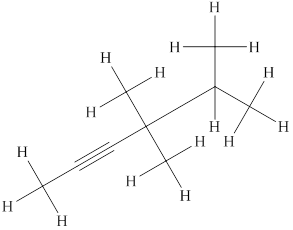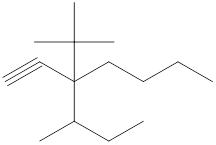
(a)
Interpretation:
The structural formula for the given compound is to be drawn.
Concept introduction:
The systematic naming of organic compound is given by
Rules for writing IUPAC name from structural formula are:
• First identify the longest carbon chain.
• The next step is to identify the groups attached to the longest chain.
• Identify the position, location, and number of the substituents bonded to the carbon chain.
• Use prefix di, tri, tetra if same type of substituents are present.
• Name the substituents in alphabetical order.
Answer to Problem 12.7E
The structural formula for the given compound is shown below.

Explanation of Solution
The given compound is

Figure 1
The structural formula of the given compound is shown in figure 1.
(b)
Interpretation:
The structural formula for the given compound is to be drawn.
Concept introduction:
The systematic naming of organic compound is given by IUPAC nomenclature. The naming of organic compound is done such that the structure of organic compound is correctly interpreted from the name.
Rules for writing IUPAC name from structural formula are:
• First identify the longest carbon chain.
• The next step is to identify the groups attached to the longest chain.
• Identify the position, location, and number of the substituents bonded to the carbon chain.
• Use prefix di, tri, tetra if same type of substituents are present.
• Name the substituents in alphabetical order.
Answer to Problem 12.7E
The structural formula for the given compound is shown below.

Explanation of Solution
The given compound is

Figure 2
The structural formula of the given compound is shown in figure 2.
(c)
Interpretation:
The structural formula for the given compound is to be drawn.
Concept introduction:
The systematic naming of organic compound is given by IUPAC nomenclature. The naming of organic compound is done such that the structure of organic compound is correctly interpreted from the name.
Rules for writing IUPAC name from structural formula are:
• First identify the longest carbon chain.
• The next step is to identify the groups attached to the longest chain.
• Identify the position, location, and number of the substituents bonded to the carbon chain.
• Use prefix di, tri, tetra if same type of substituents are present.
• Name the substituents in alphabetical order.
Answer to Problem 12.7E
The structural formula for the given compound is shown below.

Explanation of Solution
The given compound is

Figure 3
The structural formula of the given compound is shown in figure 3.
(d)
Interpretation:
The structural formula for the given compound is to be drawn.
Concept introduction:
The systematic naming of organic compound is given by IUPAC nomenclature. The naming of organic compound is done such that the structure of organic compound is correctly interpreted from the name.
Rules for writing IUPAC name from structural formula are:
• First identify the longest carbon chain.
• The next step is to identify the groups attached to the longest chain.
• Identify the position, location, and number of the substituents bonded to the carbon chain.
• Use prefix di, tri, tetra if same type of substituents are present.
• Name the substituents in alphabetical order.
Answer to Problem 12.7E
The structural formula for the given compound is shown below.

Explanation of Solution
The given compound is

Figure 4
The structural formula of the given compound is shown in figure 4.
(e)
Interpretation:
The structural formula for the given compound is to be drawn.
Concept introduction:
The systematic naming of organic compound is given by IUPAC nomenclature. The naming of organic compound is done such that the structure of organic compound is correctly interpreted from the name.
Rules for writing IUPAC name from structural formula are:
• First identify the longest carbon chain.
• The next step is to identify the groups attached to the longest chain.
• Identify the position, location, and number of the substituents bonded to the carbon chain.
• Use prefix di, tri, tetra if same type of substituents are present.
• Name the substituents in alphabetical order.
Answer to Problem 12.7E
The structural formula for the given compound is shown below.

Explanation of Solution
The given compound is

Figure 5
The structural formula of the given compound is shown in figure 5.
(f)
Interpretation:
The structural formula for the given compound is to be drawn.
Concept introduction:
The systematic naming of organic compound is given by IUPAC nomenclature. The naming of organic compound is done such that the structure of organic compound is correctly interpreted from the name.
Rules for writing IUPAC name from structural formula are:
• First identify the longest carbon chain.
• The next step is to identify the groups attached to the longest chain.
• Identify the position, location, and number of the substituents bonded to the carbon chain.
• Use prefix di, tri, tetra if same type of substituents are present.
• Name the substituents in alphabetical order.
Answer to Problem 12.7E
The structural formula for the given compound is shown below.

Explanation of Solution
The given compound is

Figure 6
The structural formula of the given compound is shown in figure 6.
Want to see more full solutions like this?
Chapter 12 Solutions
OWLV2 WITH MINDTAP READER FOR SEAGER/SL
- Fill the table below by proving an Alkene other than Ethene and 2-pentene.arrow_forwardWhich of the statements about the hydration of alkenes and alkynes are true? * A- Both alkenes and alkynes are nucleophiles in addition reactions. B- Alkenes that are sensitive to rearrangement can be hydrated indirectly using Hg²⁺ as the hydration catalyst followed by reduction. C- The hydration of alkenes and alkynes both involves one nucleophilic addition step. D- All these statements are true. E- None of these statements are true.arrow_forwardWrite structures that correspond to the names given. a) 1,2-pentadiene b) 3-bromocyclopentene C)3,3-dichloro-1-pentyne d) cyclohexylethynearrow_forward
- complete the reactions draw the product from the reaction of HBr and 2-butenearrow_forwardIndustiral Chemistry Both Tetraethyl lead and methyl-t-butyl ether have been removed from or in the process of being removed from the gasoline additive industry. Explain why each of these compounds were used so highly, and why each is considered dangerous.arrow_forwardDescribe (meaning what you would do and observe) simple (not including melting points, boiling points, cleaving reactions, or instrumental analyses) chemical tests (if any) that would distinguish between the compounds named below. [ Hint: using a table may be helpful ] A. 1,3-pentadiene & 1-pentyne B. allyl bromide & 2,3-dimethyl-1,3-butadienearrow_forward
- Using your knowledge, explain why 1- dimethyl 2- bromopropane is difficult to purify using 2-methyl-2-butene as the starting compound. Use structures in your answer.arrow_forwardDraw the structure of 1,4-cyclohexadiene. The “1,4” can appear in another place in the name. Write that name.arrow_forwardwhich would be expected to convert 1 mole of 4-methyl-1-pentyne into 2-methylpentane? Na, NH3(l) 2 moles H2, Pt 1 mole H2, Pt 2 moles of HCl H2, Lindlar’s catalystarrow_forward
- 1. How will you carry out the following reactions? a. Combustion b. Bromination c. Oxidation2. Based on their chemical structures (both shape and atomic make-up), do you expect hydrocarbons (in general) to be more, or less, dense than water? Describe how it was done in the lab. 3. What colors are bromine and potassium permanganate solutions? 4. Name a substance/solution that could be used to distinguish alkane from an alkene. 5. Describe the general properties of hydrocarbons based on what you’ve learned in the module.arrow_forwardb) Identify the process/reaction and draw the chemical structure for each below.i. ethene to polyetheneii. hexane to benzeneiii. octane to paraffin and olefiniv. heptane to 2,2 – dimethylpentanearrow_forwardHow many different alkenes can be formed from the haloalkane in Figure 20? Take stereoisomerism into account.arrow_forward
 Organic Chemistry: A Guided InquiryChemistryISBN:9780618974122Author:Andrei StraumanisPublisher:Cengage LearningChemistry: Matter and ChangeChemistryISBN:9780078746376Author:Dinah Zike, Laurel Dingrando, Nicholas Hainen, Cheryl WistromPublisher:Glencoe/McGraw-Hill School Pub Co
Organic Chemistry: A Guided InquiryChemistryISBN:9780618974122Author:Andrei StraumanisPublisher:Cengage LearningChemistry: Matter and ChangeChemistryISBN:9780078746376Author:Dinah Zike, Laurel Dingrando, Nicholas Hainen, Cheryl WistromPublisher:Glencoe/McGraw-Hill School Pub Co ChemistryChemistryISBN:9781305957404Author:Steven S. Zumdahl, Susan A. Zumdahl, Donald J. DeCostePublisher:Cengage Learning
ChemistryChemistryISBN:9781305957404Author:Steven S. Zumdahl, Susan A. Zumdahl, Donald J. DeCostePublisher:Cengage Learning


